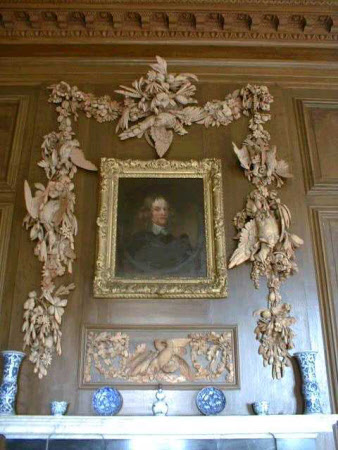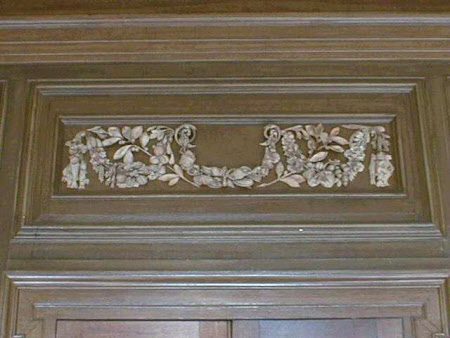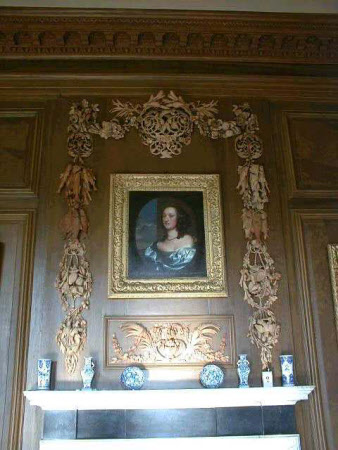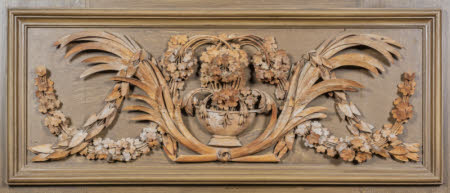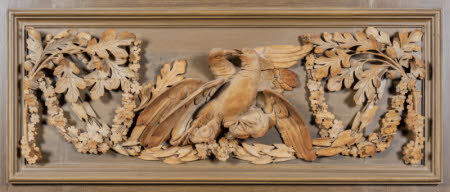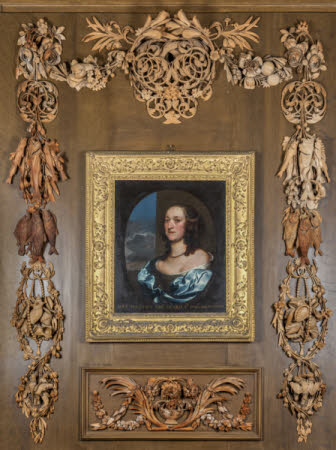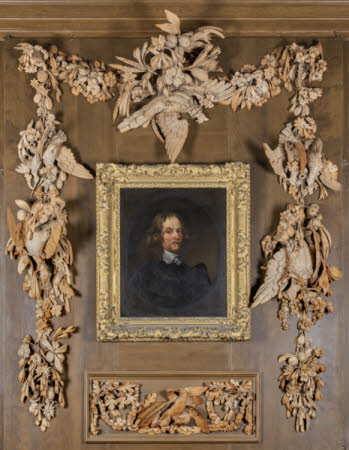Carved limewood overmantels and panels, attributed to Grinling Gibbons and by Edmund Carpenter
style of Grinling Gibbons (Rotterdam 1648 - London 1721)
Category
Art / Sculpture
Date
circa 1688
Materials
Limewood
Place of origin
Great Britain
Order this imageCollection
Belton House, Lincolnshire
NT 435033
Summary
Limewood, carved applique overmantels and panels in the style of Grinling Gibbons (1648-1721) and attributed to Edmund Carpenter, c.1688. One of five applique overmantels and frieze panels carved of limewood depicting fruit, flowers, foliage, gamebirds, fish and shells (NT 435033.1–435033.5).
Full description
NT 435033.1, an overmantel attributed to Grinling Gibbons, c.1688, comprised of a central swag and two drops descending at left and right. The central swags are crested with a spray of flowers, fruit and ears of wheat against which a dead pheasant hangs, with its wings outstretched and neck feathers bristling. The drops show dead game including duck, pigeon, snipe or woodcock and pheasant hanging from garlands heavy with fruit, flowers and foliage. Primrose, shamrock, crocus, tulip and buttercup can be seen as well as plums, pears, wheat, barley, seedpods and catkins. Installed below this overmantel is NT 435033.3, a limewood panel showing doves feeding against oak sprays with swags of phlox and arrowhead vine. This may have been brought from the mansion of Viscount Tyrconnel (1690-1754) at Arlington Street, London, where, according to the 1738 Inventory, there hung in a passage ‘A fine piece of carving in a panel by Gibbons’. In 1856 William Gibbs Rogers (1792-1875), woodcarver, restorer and leading authority on Gibbons, was employed at Belton to oversee the repair and conservation of its 17th-century woodcarvings (The Art-Journal, vol.II, 1856, p.85 and Rogers 1866-7, pp.179-86). Rogers himself is attributed to several carvings at Belton, and worked tirelessly to preserve Gibbons’ carvings in country houses across Britain which had been ravaged by woodworm. In a letter dated 17 March 1863 to the 2nd Earl Brownlow (1842-67) Rogers refers to a carving ‘by’ Gibbons, although does not specify its location. The letter includes a copy of a letter received by Rogers from ‘G A Lowe | Clerk of the Wks [Works]’ reporting on the status of ‘the very beautiful carving by Gibbons’ at Belton House. Lowe reports: ‘I am glad to inform you that there is never any appearance of worm dust from the very beautiful carving by Gibbons since you [Rogers] preserved it years back…I should say there is not a worm in the whole of the carving, but before it was preserved I have no doubt from the appearance of various parts broken there must have been thousands. It is a very good thing the destruction is stopped so that such a beautiful piece of work may be left for years to come.’ (Brownlow Papers, Lincolnshire Archives, BNLW 2/2/3/10/12). Although no archival evidence exists to prove Gibbons’ authorship it is a conceivable attribution (Esterley 1998, p.97). NT 435033.2, an overmantel by Edmund Carpenter, 1688, comprised of central swags and two drops descending at left and right. The central swags of fruit, buttercup, primrose and foliage are crested with an intricate double acanthus scroll interlaced with sprays of wheat. For the drops bunches of rose and acanthus scrolls are trussed with fish, shells and game birds. The angler’s catch includes freshwater fish like trout, perch, salmon and carp and marine fish like bass and plaice (Marsden 1987, p.9). Of the clustered shells, which are encased in a string of pearls, abalone, cowrie, conch, turritella, scallop and mussel can be seen. The drops conclude in pigeon and snipe, trussed and hung, framed by a garland of catkins, acanthus, crocus and seedpods. A bill for £26 10s was presented by Carpenter for a ‘very rich Chimny peece’ in the ‘greate Parlor don wth varieties of fish and sheals | with birds fouliage fruit & flowers…’ The same bill lists NT 435096, a frieze panel which is now installed in the Tyrconnel Room. Installed below this overmantel is NT 435033.4, a carved limewood panel attributed to Edmund Carpenter. It shows swags of anemone extending from a central bouquet and vase, framed by two sprays of palm each draped with arrowhead vine. The differences in composition between NT 435033.1 and NT 435033.2 show that the overmantels were not conceived as a pair. It is likely that they were moved here from other parts of the house in the late 19th century. It was also probably at this time that the drops on NT 435033.2 were lengthened to include more fish, possibly in light of restoration work. NT 435033.5, a carved limewood panel attributed to Edmund Carpenter, c.1688, installed over the door connecting the Marble Hall to the Saloon. The motif of shells and fish among swags of flowers, fruit and foliage associates it with overmantel NT 435033.2. The central swag features acanthus scrolls and clusters of abalone, cowrie, conch and turritella shells encased in a twisted string of pearls. The swags to the left and right show plums, walnuts, catkins, cobnuts, anemone, roses and barley and end in bunches of freshwater fish. The fish to the left are noticeably cruder than those on the right, indicating that this panel is the work of several hands or that these fish were a later addition, possibly late 19th century when bunches of fish were added to lengthen the drops on NT 435033.2. Alice Rylance-Watson October 2018
Provenance
Acquired by Sir John Brownlow (1659-97) c.1688. Purchased with a grant from the National Heritage Memorial Fund (NHMF) from Edward John Peregrine Cust, 7th Baron Brownlow, C. St J. (b.1936) in 1984.
Credit line
Belton House, The Brownlow Collection (acquired with the help of the National Heritage Memorial Fund by the National Trust in 1994)
Makers and roles
style of Grinling Gibbons (Rotterdam 1648 - London 1721), woodcarver
References
The Art-Journal, vol.II, London, 1856, p.85 Rogers 1856, William Gibbs Rogers 'Remarks upon Grinling Gibbons', Sessional Papers of the Royal Institute of British Architects, 1866-7, pp.179-86 Esterly1998: David Esterly, Grinling Gibbons and the art of carving, V&A Publications, London 1998, p.97 Marsden 1987: Jonathan Marsden, Belton House, Lincolnshire, The National Trust, London, 1987, p.9 Tipping, 1913: Henry Avray Tipping, Grinling Gibbons and the Woodwork of his Age 1648-1720, 1913, pp.185-201
